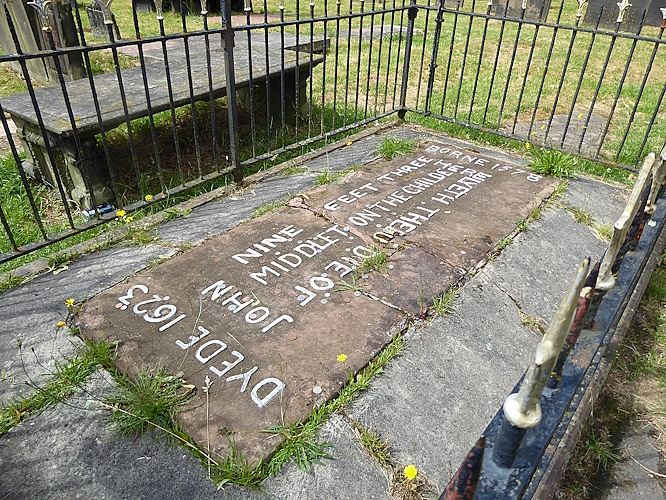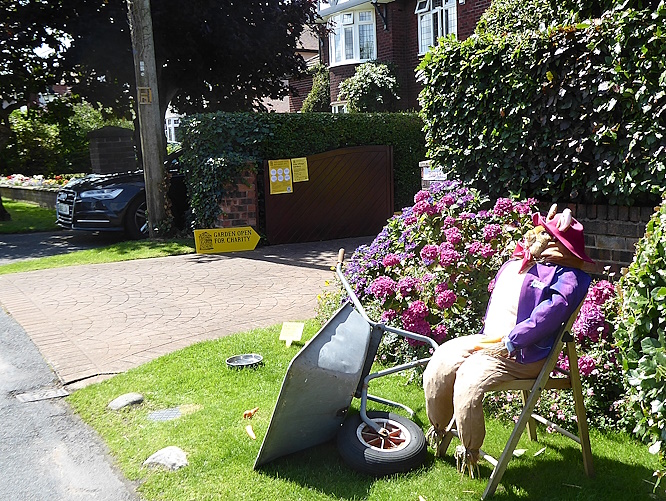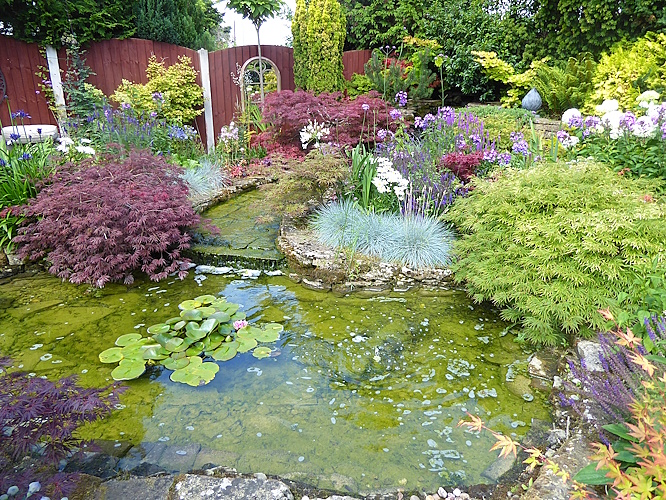Another day of looking around private gardens with the National Garden Scheme, which raises money for good causes. This time we were in Hale, a village south of Liverpool, an oasis of thatched cottages, which the modern world seems to have overlooked. These are not, of course, tiny labourers’ hovels, but very desirable residences indeed. The bus dropped us in the village centre and we headed for the churchyard for an early lunch. Some of the gravestones are very old, and the most famous of them is that of the Childe of Hale, a man called John Middleton (1578-1623) who was said to have grown to 9 feet 3 inches.

There has been a church on this site since at least 1081, and we looked for an ancient Yew tree. There IS a Yew next to the church, but it only looks a few hundred years old.

As we headed down Church Road towards the first of our five open gardens there were Greenfinches calling and Goldfinches on the TV aerials. The open garden at number 54 was hard to miss, with a yellow direction sign and a welcoming scarecrow.

It was a very long garden, with a wonderful view from the back end, over the Mersey to Wirral, with the Welsh hills beyond.


There were hazel nuts ripening and a couple of Comma butterflies, my first of the year.

The second garden, at 4 Church Road, was notable for its curved flowerbeds at the back and the lovely border at the front.

The third garden, 33 Arklow Drive, was a modern garden divided into “rooms”. I don’t really like what is done to trees in these sorts of gardens. It had three “pop-pom” Gingkoes, where a tight ball of foliage was grafted onto a tall bare trunk of something else. I wish they would just leave them alone! But the two young Indian Bean trees on either side of an archway were being left to grow more naturally.

A nearby house at 2 Pheasant Field belonged to the mother of the previous gardener, and collectively they are Radio Merseyside’s “Garden Girls”. This garden had more grafted and severely-pruned trees, but the pond and its cascade were amazing, and the Sea Holly (Eryngium sp.) was attracting hordes of bees.


Then we had a long walk along Hale Road, past the really wonderful houses. One had very cute curvy thatch and another was rendered in pink with a pink car outside. Very Lady Penelope! I suspect the residents were less than pleased when Liverpool airport expanded some years ago, and now they get low-flying planes passing right overhead every few minutes.


Our last call was 33 Hale Road, a house with a huge garden, clusters of seats scattered around, and a roaring trade in tea, cake and Pimm’s. All proceeds go to the group of medical charities supported by the scheme, and last year the Hale gardens group raised £6,242.72.

In the back of the garden there was a huge old Oak with a seat built around it, and a tool-shed with a sedum roof. The large pond had Emperor dragonflies on it, with a female laying eggs.

It had been dry, hot and humid all day, but now clouds were gathering. We managed to get the bus back while it was still dry, but it rained torrentially while we were on the bus back to town.
Public transport details: Bus 82A from Liverpool ONE at 10.12, arriving Hale Village Green at 11.05. Returned from Hale, Bailey’s Lane on the 82A at 15.02, arriving Liverpool 3.50
